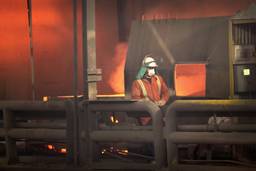Uncertainty? Just Ask The Middle Class
America’s trade relationship with China costs us millions of manufacturing jobs.
Leo Gerard, United Steelworkers President

“Uncertainty” is the pitchfork that corporations now effectively wield to prod politicians into action. It’s a threat, as in, if Congress doesn’t do this or that, such as avoid the fiscal cliff or raise the debt ceiling, then corporations will suffer the unbearable pain of “uncertainty.”
Uncertainty is really, really bad, business lobbyists lament. It’s a terrible thing to do to corporations, business commentators contend on talk shows.
They’re unconcerned, however, when the American middle class suffers uncertainty. Or when government action shifts uncertainty to the middle class. Trade is the perfect example of that. In 2000, Congress ended China’s uncertainty about trade with the United States by transferring that pain to America’s middle class. It was an excruciating loss of certainty for American workers because over the next seven years, millions of U.S. manufacturing jobs disappeared. That’s trade that hurts.
Here’s what happened: In October of 2000, the United States granted to China Permanent Normal Trade Relations (PNTR). That ended annual reviews of China’s trade status, during which Congress could change tariff levels on individual products.
Two researchers, Justin R. Pierce and Peter K. Schott of the nonpartisan economic study group National Bureau of Economic Research, found that it wasn’t reduction of tariffs that dramatically increased exports from China to the United States after 2000. In fact, tariffs remained about the same. It was instead elimination of uncertainty about tariff levels that prompted the rise.
The effect was massive manufacturing job losses in the United States, Pierce and Schott write in a report published late last month, “The Surprisingly Swift Decline of U.S. Manufacturing Employment.” They calculated that if Congress had rejected the PNTR agreement, the United States would have employed 4 million more manufacturing workers in 2007 than it actually did. That is 4 million manufacturing workers who were laid off or never hired.
That is 4 million more American workers who would be in good-paying, family-supporting manufacturing jobs right now. At a time of high unemployment. Four million is almost half of the 8.8 million jobs lost throughout the Great Recession that began in 2007. Unemployment would be a lot lower with 4 million more jobs right now. So would middle class uncertainty.
Pierce and Schott do not account for the millions of non-manufacturing jobs that would have been created or preserved without the PNTR because each good-paying factory job supports many others in communities. And the researchers do not discuss the burden of uncertainty that the PNTR agreement imposed on American workers as manufacturing jobs vanished.
The PNTR and China’s acceptance immediately afterward into the World Trade Organization (WTO) were supposed to be great. That’s what the free traders said.
If Congress rejected the PNTR, the free traders contended, Europe and Japan would gain access to the Chinese market of 1 billion people. America would lose out.
They said Congress had to pass the PNTR agreement so American corporations would benefit from the trade commitments China would make to become a member of the WTO.
For example, in pressing Congress to pass the agreement, the Brookings Institution noted that China promised to allow foreign corporations to set up wholly-owned distribution, sales, shipping and service networks; provide financial services institutions full market access within five years, and protect intellectual property.
And how has that worked out for American corporations? Not so well, actually.
China is notorious for its piracy of American intellectual property—from patented devices to copyrighted music and films. A dozen years after the PNTR agreement, China continues to frustrate American firms’ attempts to establish wholly-American-owned facilities there. And American financial institutions still don’t have access to the Chinese market.
Just like with cars, auto parts, tires, solar panels, wind turbines and many other manufactured products, a trade case had to be filed to force China to honor its commitments regarding financial institutions. And just like so many other trade cases, China lost.
Over the past decade, while the American economy has limped along, China has surged. Economic growth in the United States was 1.7 percent in 2011. It was 9.2 percent in China.
And much of that is based on Chinese exports. America’s trade deficit with China in 2000 before the PNTR took effect was $83 billion. It was more than three times that last year — $290 billion. No matter what the free traders say, that’s not good.
That trade deficit is not because America can’t compete. America could if China honored its trade commitments. But it doesn’t.
The upshot is uncertainty for American workers.
The researchers Pierce and Schott found that if America had never entered into the PNTR agreement with China, manufacturing employment would be 10 percent higher than in 2000. Because it did enter the agreement, manufacturing employment declined instead — by 15 percent.
In addition, they write that the relationship between the imports and job losses is direct:
“U.S. imports surge in precisely the set of goods where domestic employment loss is concentrated.”
The researchers note that U.S. firms can profit from this situation by switching to Chinese suppliers of parts.
That may be great for corporate bottom lines, but it is bad for America as the nation loses both jobs and its capacity to manufacture.
If America can’t manufacture No. 2 pencils, how long will it be before it can’t manufacture ballistic missiles? Maybe that’s the pitchfork manufacturing workers need to prod politicians to deal with middle class job uncertainty.
Full disclosure: The United Steelworkers union is a sponsor of In These Times.







